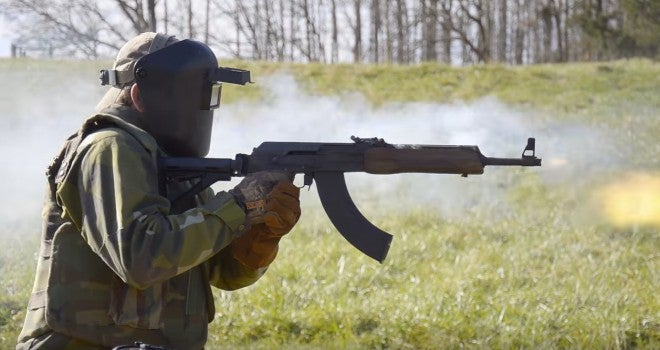Gun blogger superstar Eric of the Iraqveteran8888 YouTube channel is happy to once again get behind a rifle going cyclic until failure. This time, Eric’s victim is a Vepr 7.62×39 AK rifle made by Molot and modified by Copper Custom. Those who watch these videos should know that burnout tests like this are not particularly safe; parts are liable to fail, rounds cooking off are a virtual guarantee, and they are – natrually – a fire hazard, as well. Having said that, Eric will do it so you don’t have to, so enjoy the video below:
The end result of shooting the Vepr was a weapon that locked up – the action unable to be worked by hand – after the end of 895 rounds of 7.62x39mm ammunition down the spout in one session. Eric previously tested a WASR-10 AK, which only was able to fire 265 rounds before the barrel drooped too far for the piston to align with the gas block, preventing the weapon from going into battery.
At the end of the Vepr test, Eric, undaunted by the gun’s failure, did a little Eastern Front armorer work on the rifle (banging the rifle against the shooting table), allowing the bolt to come back with less effort. He charged the rifle, and fired another 75 round drum through the rifle, which appeared to finally solve the problem and get the rifle back in action.
There’s a little post-hoc analysis we can do after the fact. Eric’s previous test of an AR-15 resulted in a barrel failure at 830 rounds, the rifle’s Faxon M4-profile barrel bursting just behind the gas block. One thing Eric does not mention is that these burnout tests are much more a torture of the barrel than they are of the rifle’s operating group. Certainly, as seen in the WASR test, the barrel can droop far enough that the gas block does not accept the piston head anymore, or in the case of some AR-15 tests, the gas tube can burst due to heat, but beyond that it is the barrel that takes almost all of the punishment in tests like these. So why did the Vepr perform better than either the AR-15 or WASR? Simply, because its barrel was a much heavier profile than the barrels of either of those rifles, and, vs. the AR-15, it was shooting a round (7.62×39) which generates less waste energy in the form of heat. Some basic statistics (collated by myself) about the barrels and ammunition of the three rifles is given below:
Vepr barrel:
Cold hammer forged, chrome-lined, 0.790″ diameter heavy profile, .311″ internal diameter
Barrel wall thickness: .2395″
Failure point: 895 rounds
AR-15 barrel:
Drilled, button-rifled, nitride 0.750″ (gas block)/0.640″ (under handguards*) diameter M4 profile, .224″ internal diameter
Barrel wall thickness: .2080″ (under handguards*)
Failure point: 830 rounds, *note that failure occurred under the handguards
WASR-10 barrel:
Cold hammer forged, chrome-lined, .592″ diameter AKM profile, .311 internal diameter
Barrel wall thickness: .1405″
Failure point: 265 rounds
Below the respective thermal efficiencies of 5.56x45mm and 7.62x39mm have been calculated. The thermal efficiency was derived from Powley computer calculations. Wasted heat is the remainder of the energy created by the cartridge that is left in the barrel; this is the primary cause of barrel heating during firing (heating due to friction is a small fraction of total heat created):
5.56×45:
Thermal efficiency: 27.1%
Wasted heat: 4339 J
7.62×39:Thermal efficiency: 34.4%
Wasted heat: 3877 J
Just taking these numbers at face value, we should expect a 5.56mm barrel to fail at 0.89 times the rounds that an otherwise identical 7.62x39mm barrel fails at. Given that we saw a catastrophic failure of the AR-15 at 0.93 times the round count at which the 7.62x39mm Vepr’s barrel began to fail, this prediction actually aligns fairly well with our results. Had the Vepr’s barrel failed with the next magazine or two, it would almost exactly match the prediction based on the efficiencies of the two respective rounds. Now, this ignores the slightly heavier contour of the Vepr’s barrel, so it’s possible that – gas block alignment discounted – the rifle could have failed somewhat later.
I’ll have to differ with Eric in his assessment. The Vepr’s excellent performance doesn’t so much prove that AK-pattern rifles will work until Judgement Day so much as it proves that the heavy contour CHF chrome-lined barrels Molot uses have excellent thermal resistance properties. This makes sense, as the Vepr is itself based on the RPK automatic rifle!
 Your Privacy Choices
Your Privacy Choices
